Is it mole? A vole? These small mammals are often confused with each other, probably because they’re both associated with tunnels. But they’re really quite different and, depending on the circumstance, could be a pest — or not. Since the first step in IPM is to identify your problem, let’s shed light on these two critters.
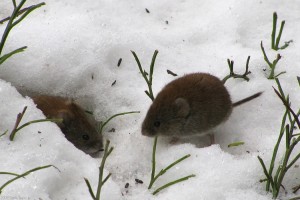
VOLES
Since voles are seen above-ground much more often than the elusive mole, let’s take a look at them first. You might see them darting through lawns during the day (or your cat might bring them home). They’re active day and night year-round where the ground cover is thick. These small rodents are herbivores, eating almost exclusively plants.
At a quick glance you might confuse them with mice, but their stocky bodies are more compact and they look like they are missing half their tail. Also, unlike mice, they are adapted for digging; different species have different tunneling behavior, which can help with identification.
Voles often have several litters per year. Their populations can fluctuate a good deal — meaning that sometimes they’re quite abundant while other times it would take a naturalist’s sharp eye to know they’re even around.

Meadow Voles (Microtus pennsylvanicus) are the most abundant vole species found throughout New York and are common in grassy areas including lawns. They are dark brown with a grayish belly and can be 5 inches long.
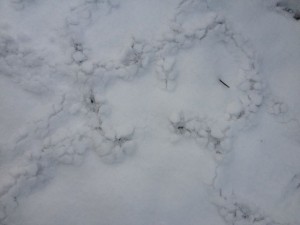
How do you know if you have meadow voles? Besides actually seeing them (or receiving one in a display of cat love), signs include:
- runways through the turf, most visible after snow melt
- girdled woody plants
- chewed-off herbaceous vegetation
- ground burrow openings
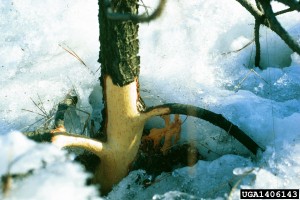
After the snow melts, vole damage becomes obvious. Photo Credit: USDA Forest Service – North Central Research Station Archive, USDA Forest Service, Bugwood.org
Pine Voles (Microtus pinetorum) probably live throughout New York except for parts of the North Country, although actual distribution is uncertain. Their preferred habitat is forests with thick ground cover; they like orchards too. They are auburn colored and can be four inches long.
Pine voles are harder to detect as they don’t use surface runways. Their extensive underground tunnel systems lead them to their favorite food source, the roots of woody plants.
MOLES
Once you’ve seen a mole, you’ll have a hard time confusing it with any other animal. Their broad feet, adapted strictly for digging, give them away. Everything about this animal is a clue that it lives underground. Moles have no external ears that can get caught as they move through their tunnels. Their dark, shiny fur has no grain, allowing them to move forwards and backwards with equal ease. And their eyes? You’d practically have to catch a mole to get close enough to see them — they’re that small.
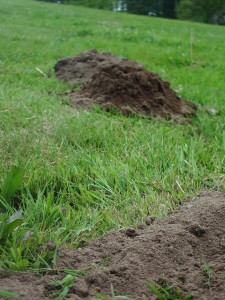
What are they looking for — feeling for — down there? As insectivores, they’re searching mostly for earthworms. But they’re also happy to eat insect larvae, including grubs, and other underground invertebrates. They don’t eat vegetation, although they will line their nests with grass.
Largely solitary, moles are active year-round, day and night. They create grass-lined nests in burrows 1 ½ to 2 feet below the surface often under something solid such as tree roots, sidewalks, and buildings. Litters of 4 or 5 pups are born in the spring. Maturing quickly, the young are independent at about one month old.
What are indications that you have moles? You will find low ridges or mounds of dirt with no entry holes.
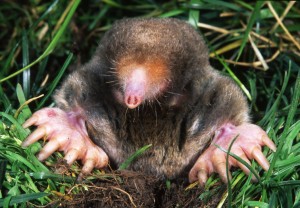
It is up for debate whether Eastern Moles (Scalopus aquaticus) are found in New York, although it’s possible they’re in the lower Hudson River Valley, the metro New York area, and Long Island. We do know they prefer moist sandy loam soils. They can be up to 6 ½ inches long with a naked tail.
Hairy-tailed Moles (Parascalops breweri) are found statewide. They can be up to 5 ½ inches long and have a short, hairy tail.
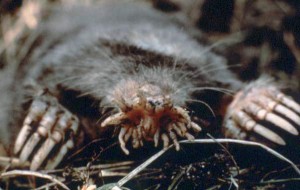
Star-nosed Moles (Condylura cristata) are found throughout much of New York, often occurring in low, wet ground especially near water. They can be up to 5 inches long, and their most striking characteristic is the fingerlike, fleshy projections surrounding their noses. More than their noses separate them from other mole species. They are more sociable than other moles. They tend to have larger litters. And Star-nosed moles swim! Who knew that those large feet are also good for paddling?
MANAGEMENT
All mole and vole species in New York are legally classified as “unprotected”. For more information on both these mammals, including IPM strategies should voles chew the bark off your ornamental shrubs or moles turn parts of your lawn upside down, visit Cornell’s Wildlife Damage Management Program website.
Adapted from Moles and Voles of New York State by Lynn Braband, NYS Community IPM Program at Cornell University